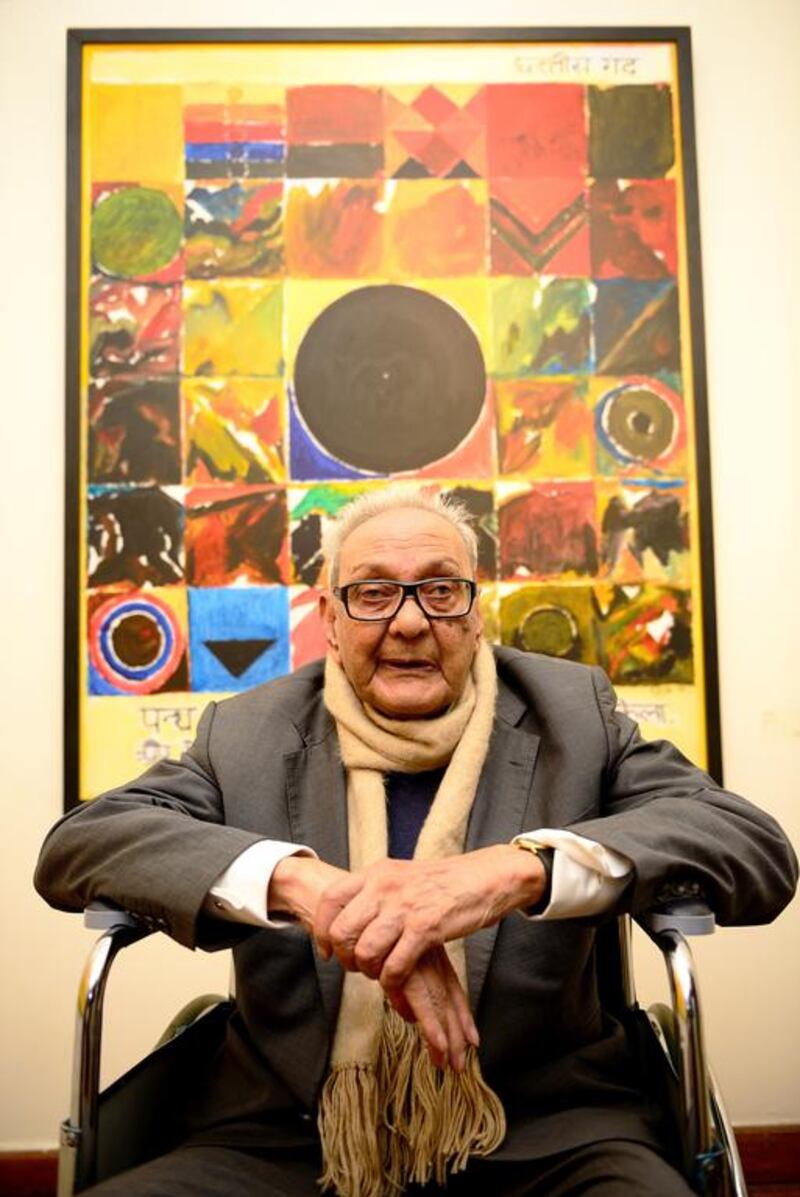NEW DELHI // Syed Haider Raza, the last surviving member of the six modern artists who founded the influential Bombay Progressive Artists’ Group in 1947, has died. He was 94.
Mourners gathered in the Mandla district of Madhya Pradesh state on Sunday as Raza’s last rites were conducted in the village in which he was born in 1922.
Raza, who died in New Delhi on Saturday, continued to paint into his nineties, channelling both Hindu and Islamic philosophies into his work. With their bold colours and geometric abstractions, his paintings were simple yet striking.
“There’s a lyricism in his work, and the intellectual progression of his ideas is incredible,” said Minal Vazirani, a founder of Indian auction house Saffronart. “So much of it was so visually powerful.”
Collectors and galleries valued his work highly. In 2010, Raza's Saurashtra, a monumental canvas, was auctioned by Christie's in London for nearly US$3.5 million (Dh12.85m) – a record at that time for any modern Indian artist.
“In his death, the nation has lost a highly creative and acclaimed artist,” president Pranab Mukherjee said in a condolence message. “His death leaves a void in the world of art and creativity which will be difficult to fill.”
The artist had been ailing for nearly a month and a half, from various complications of health and old age.
His wife, the French artist Janine Mongillat, died of cancer in 2002. They had no children.
“I was not fond of school,” he said five years ago. “I was a bad student scoring low marks. Arithmetic did not interest me. My interest lay in drawing and painting.”
He attended the Nagpur School of Art from 1939 to 1943 and then the JJ School of Art in Mumbai from 1943 to 1947. Soon after he graduated, India became independent, and he joined forces with five fellow artists – including MF Husain – to form the group that spearheaded India’s modern art movement.
The group lasted barely nine years, but its influence on Indian art was significant. Convinced that Indian art had to become more modern, and to break with established tradition, the Progressives set themselves a manifesto.
“Today we paint with absolute freedom for content and technique, almost anarchic; save that we are governed by one or two sound elemental and eternal laws of aesthetic order, plastic coordination and colour composition,” said FN Souza, one of the Progressive group’s original artists.
Raza’s early works were not abstract. He painted urban scenes with quick, discernible brushstrokes, often in water colour, reminiscent of Paul Cezanne. He took this style with him when he moved to Paris in 1950 for a scholarship. He continued to live in France until the death of wife, moving back to New Delhi in 2002.
Even during his decades overseas, Raza continued to maintain strong ties with his homeland, visiting often and drawing inspiration from Indian themes.
“He drew on influences from all over,” said Ms Vazirani, who knew Raza well. “He would draw on American abstract expressionism, but he would also look at Hindu philosophy, and he would incorporate both elements seamlessly into one canvas. He was brilliant.”
According to his friend Ashok Vajpeyi, Raza was eight when Mahatma Gandhi visited Mandla where he came from. "It left a strong impression on the young boy," Mr Vajpeyi told the Economic Times newspaper on Sunday. "Once Raza told me the reason why he remained a citizen of India even while living in France for 60 years: he felt he could not betray Gandhi."
India also provided Raza with the philosophical impetus for his reinvention, when in the 1970s he moved away from landscapes and urban scenes and towards the geometric abstraction he is best known for.
“Nature became to Raza something not to be observed or to be imagined but something to be experienced in the very act of putting paint on canvas,” the Mumbai-based art critic Rudolf von Leyden wrote in 1979.
Many of Raza’s later paintings revolved around the metaphysical concept of the “bindu” – literally a dot, but also the symbol for a seed, the source of all life. “The bindu awakened a latent energy inside me,” he said in a 2006 interview.
When it enters a Raza painting, the bindu is impossible to miss.
In Kundalini, a 1999 work that takes its name from the Hindu concept of a primal energy located at the base of the human spine, myriad blue concentric circles radiate out from the bindu, as if emitting waves of energy. The effect is charged yet harmonious.
Throughout his career, Raza won a number of awards in both India and France. These included the Prix de la Critique and Legion d’Honneur in France, and the Padma Bhushan and Padma Vibhushan in India.
“Raza pushed the boundaries for himself and for Indian modernism,” Ms Vazirani said. “He formed a cornerstone of modern Indian art.”
ssubramanian@thenational.ae





